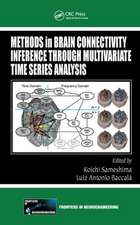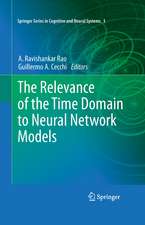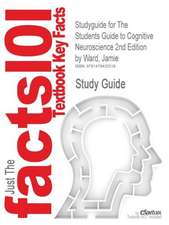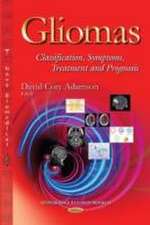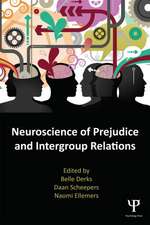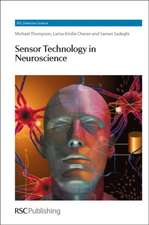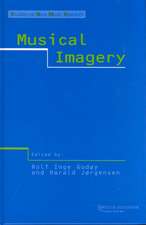The Frog Who Croaked Blue: Synesthesia and the Mixing of the Senses
Autor Jamie Warden Limba Engleză Paperback – 26 mar 2008
Everyone will be closely acquainted with at least 6 or 7 people who have synesthesia but you may not yet know who they are because, until very recently, synesthesia was largely hidden and unknown. Now science is uncovering its secrets and the findings are leading to a radical rethink about how our senses are organized. In this timely and thought-provoking book, Jamie Ward argues that sensory mixing is the norm even though only a few of us cross the barrier into the realms of synesthesia.
How is it possible to experience color when no color is there? Why do some people experience touch when they see someone else being touched? Can blind people be made to see again by using their other senses? Why do scientists no longer believe that there are five senses? How does the food industry exploit the links that exist between our senses? Does synesthesia have a function? The Frog Who Croaked Blue explores all these questions in a lucid and entertaining way, making it fascinating reading for anyone with an interest in the intriguing workings of the mind.
| Toate formatele și edițiile | Preț | Express |
|---|---|---|
| Paperback (1) | 140.49 lei 43-57 zile | |
| Taylor & Francis – 26 mar 2008 | 140.49 lei 43-57 zile | |
| Hardback (1) | 354.20 lei 43-57 zile | |
| Taylor & Francis – 31 mar 2008 | 354.20 lei 43-57 zile |
Preț: 140.49 lei
Preț vechi: 169.52 lei
-17% Nou
Puncte Express: 211
Preț estimativ în valută:
26.88€ • 28.14$ • 22.24£
26.88€ • 28.14$ • 22.24£
Carte tipărită la comandă
Livrare economică 07-21 aprilie
Preluare comenzi: 021 569.72.76
Specificații
ISBN-13: 9780415430142
ISBN-10: 0415430143
Pagini: 190
Ilustrații: illustrations
Dimensiuni: 129 x 198 x 15 mm
Greutate: 0.36 kg
Ediția:New.
Editura: Taylor & Francis
Colecția Routledge
Locul publicării:Oxford, United Kingdom
ISBN-10: 0415430143
Pagini: 190
Ilustrații: illustrations
Dimensiuni: 129 x 198 x 15 mm
Greutate: 0.36 kg
Ediția:New.
Editura: Taylor & Francis
Colecția Routledge
Locul publicării:Oxford, United Kingdom
Public țintă
Professional Practice & DevelopmentCuprins
The Colorful Albino. Counting on the Senses. An Altered Reality. The Screen in My Forehead. Beyond the Senses.
Notă biografică
Dr Jamie Ward is a Senior Lecturer at the University of Sussex, UK, and is one of the world's leading experts on synesthesia. He has published over 40 scientific papers and several books. In addition, he has contributed to the public understanding of science through numerous talks and media coverage in newspapers, radio and television including documentaries produced by the Discovery Channel and BBC Horizon.
Recenzii
"Ward pitches his book to a broad audience. The writing is jargon free, and there are careful explanations of both scientific terms and the methods used by scientists to test hypotheses and build theories. This should make the book accessible to a range of readers… First, those with little or no scientific training may have interest in the book, including laypersons who have synesthesia and want to learn more about it. In fact, many people who read the book may discover that they are synesthetes.… Second, the book is appropriate as a supplement to university courses on topics such as sensation, perception, cognition, or cognitive neuroscience. Students should find interest in exploring how synesthetic information processes compare with the sensory processes typically covered in university courses. Third, the book may be of use to clinicians—for example, clinical psychologists, neuropsychologists, psychiatrists, neurologists—who may encounter synesthesia among their patients.… Last, the book may be of interest to scientists who have little familiarity with the topic, and even the few experts in the area should be interested in Ward’s new synthesis." – Andrew B. Slifkin & Katherine A. Koenig in PsycCRITIQUES
"Those who have become wary of popular treatments of neuroscience will be gratified by the clarity of the author’s thinking, which avoids or cuts through the simplistic reductionism and other conceptual confusions that often mar books on the brain. ... It is highly recommended to anyone with an interest in the science of conscious experience – a category that surely includes readers of this Journal." - Nick Medford, The Brighton and Sussex Medical School, University of Sussex, in British Journal of Psychiatry 194 (2009)
"A fascinating introduction to synaesthesia, explaining how the trait gives insight into the way the senses are organized. Ward also delves into other sensory experiences, such as phantom limbs and sympathetic touch, in an accessible introduction to this growing research field." - Nature, Vol 454, 31 July 2008
"Jamie Ward's exploration and research into the little-understood but totally fascinating world of synesthesia is invaluable, and his relentless passion for the topic has helped raise its profile in the public consciousness. The Frog Who Croaked Blue expertly details his research work to date and the book is a fascinating and enjoyable read into a different world." - Heston Blumenthal, chef and owner of The Fat Duck, named Best Restaurant in the World in 2005 by Restaurant magazine
"Synesthesia has long been regarded as a curiosity. In this book Jamie Ward successfully places synesthesia in a broader context and conveys the current excitement in the field." - V.S. Ramachandran, Center for Brain and Cognition, UCSD, and author of Phantoms in the Brain
"Explaining synesthesia in clear, accessible prose, this book offers profound new insights certain to fascinate anyone interested in how the brain and our senses work." - Sean A. Day, Ph.D., synesthete; creator and moderator of the Synesthesia List
"This very readable book provides an entertaining and informative foray into the fascinating world of synaesthesia, where words can have tastes, letters may be coloured, and the sound of a frog may indeed be blue. In seeking to explore and explain synaesthesia, the book covers such phenomena as visual experience in the blind, phantom limb pain in amputees, and drug-induced sensory experiences to form an interesting and highly enjoyable read." - Anina N. Rich, Macquarie Centre for Cognitive Science, Macquarie University
"Ward provides an exceedingly readable and comprehensive introduction to perhaps the most interesting area in current Psychological research. I challenge anyone not to be drawn into the fascinating world of synaesthesia, which Ward so expertly portrays. His book provides a unique perspective on the interplay between inner thought and concrete perception – and this would be of interest to anyone wishing to understand the relationship between the human mind and the world outside it." - Dr. Julia Simner, University of Edinburgh
"Ward pitches his book to a broad audience. The writing is jargon free, and there are careful explanations of both scientific terms and the methods used by scientists to test hypotheses and build theories. This should make the book accessible to a range of readers… First, those with little or no scientific training may have interest in the book, including laypersons who have synesthesia and want to learn more about it. In fact, many people who read the book may discover that they are synesthetes. … Second, the book is appropriate as a supplement to university courses on topics such as sensation, perception, cognition, or cognitive neuroscience. Students should find interest in exploring how synesthetic information processes compare with the sensory processes typically covered in university courses. Third, the book may be of use to clinicians—for example, clinical psychologists, neuropsychologists, psychiatrists, neurologists—who may encounter synesthesia among their patients. … Last, the book may be of interest to scientists who have little familiarity with the topic, and even the few experts in the area should be interested in Ward’s new synthesis." – Andrew B. Slifkin & Katherine A. Koenig in PsycCRITIQUES
"Those who have become wary of popular treatments of neuroscience will be gratified by the clarity of the author’s thinking, which avoids or cuts through the simplistic reductionism and other conceptual confusions that often mar books on the brain. ... It is highly recommended to anyone with an interest in the science of conscious experience – a category that surely includes readers of this Journal." - Nick Medford, The Brighton and Sussex Medical School, University of Sussex, in British Journal of Psychiatry 194 (2009)
"A fascinating introduction to synaesthesia, explaining how the trait gives insight into the way the senses are organized. Ward also delves into other sensory experiences, such as phantom limbs and sympathetic touch, in an accessible introduction to this growing research field." - Nature, Vol 454, 31 July 2008
"Jamie Ward's exploration and research into the little-understood but totally fascinating world of synesthesia is invaluable, and his relentless passion for the topic has helped raise its profile in the public consciousness. The Frog Who Croaked Blue expertly details his research work to date and the book is a fascinating and enjoyable read into a different world." - Heston Blumenthal, chef and owner of The Fat Duck, named Best Restaurant in the World in 2005 by Restaurant magazine
"Synesthesia has long been regarded as a curiosity. In this book Jamie Ward successfully places synesthesia in a broader context and conveys the current excitement in the field." - V.S. Ramachandran, Center for Brain and Cognition, UCSD, and author of Phantoms in the Brain
"Explaining synesthesia in clear, accessible prose, this book offers profound new insights certain to fascinate anyone interested in how the brain and our senses work." - Sean A. Day, Ph.D., synesthete; creator and moderator of the Synesthesia List
"This very readable book provides an entertaining and informative foray into the fascinating world of synaesthesia, where words can have tastes, letters may be coloured, and the sound of a frog may indeed be blue. In seeking to explore and explain synaesthesia, the book covers such phenomena as visual experience in the blind, phantom limb pain in amputees, and drug-induced sensory experiences to form an interesting and highly enjoyable read." - Anina N. Rich, Macquarie Centre for Cognitive Science, Macquarie University
"Ward provides an exceedingly readable and comprehensive introduction to perhaps the most interesting area in current Psychological research. I challenge anyone not to be drawn into the fascinating world of synaesthesia, which Ward so expertly portrays. His book provides a unique perspective on the interplay between inner thought and concrete perception – and this would be of interest to anyone wishing to understand the relationship between the human mind and the world outside it." - Dr. Julia Simner, University of Edinburgh
"Ward pitches his book to a broad audience. The writing is jargon free, and there are careful explanations of both scientific terms and the methods used by scientists to test hypotheses and build theories. This should make the book accessible to a range of readers… First, those with little or no scientific training may have interest in the book, including laypersons who have synesthesia and want to learn more about it. In fact, many people who read the book may discover that they are synesthetes. … Second, the book is appropriate as a supplement to university courses on topics such as sensation, perception, cognition, or cognitive neuroscience. Students should find interest in exploring how synesthetic information processes compare with the sensory processes typically covered in university courses. Third, the book may be of use to clinicians—for example, clinical psychologists, neuropsychologists, psychiatrists, neurologists—who may encounter synesthesia among their patients. … Last, the book may be of interest to scientists who have little familiarity with the topic, and even the few experts in the area should be interested in Ward’s new synthesis." – Andrew B. Slifkin & Katherine A. Koenig in PsycCRITIQUES
Descriere
Everyone will be closely acquainted with a few people who have synesthesia but you may not yet know who they are because, until very recently, it was largely hidden and unknown. Now science is uncovering its secrets and the findings are leading to a radical rethink about how our senses are organized.








